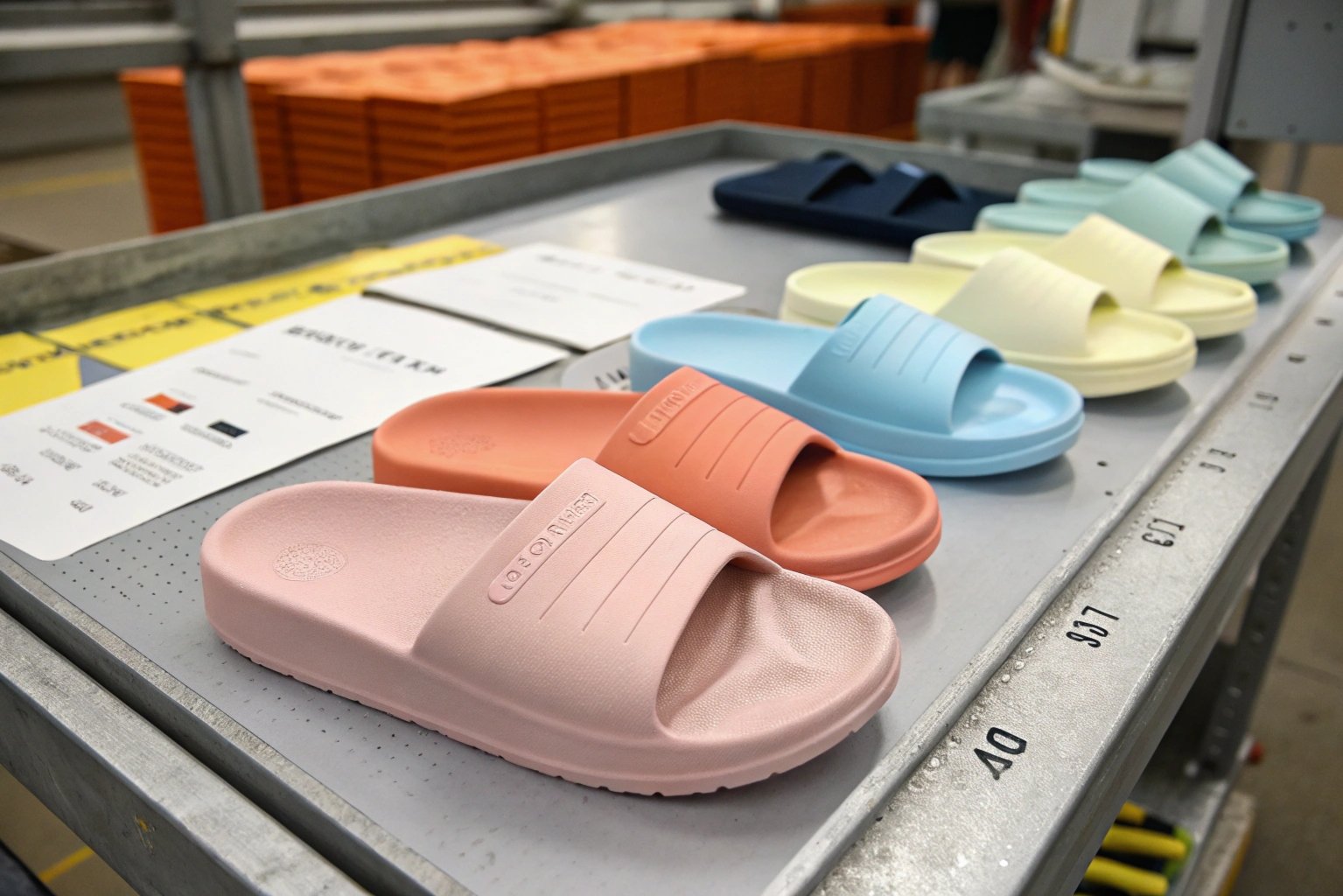Are you worried about your customers slipping in your slippers? Do you want to ensure your slippers are safe and reliable? It’s a real concern!
Testing anti-slip performance during production is key to delivering safe plastic slippers. This ensures your customers’ safety and satisfaction.

So, how do we ensure we’re making safe slippers? Let’s look at the critical tests!
How does the EN ISO 13287 standard ensure slipper safety?
Slipping can lead to falls and injuries. Ensuring your slippers meet safety standards is really important. This standard helps protect customers.
EN ISO 13287 is a European standard specifying the slip resistance test methods for footwear. It helps ensure slippers provide adequate grip and reduce the risk of slips and falls.

The EN ISO 13287 standard is crucial for evaluating slipper safety. It uses different test conditions to mimic real-world scenarios. This helps us assess the slipper’s performance on various surfaces. The standard outlines specific requirements and testing procedures. For example, it defines the materials and surface conditions for testing. It also specifies the applied force and speed during the tests. The test results are then analyzed to determine the slipper’s slip resistance coefficient. This coefficient indicates the slipper’s ability to provide grip on different surfaces. Meeting this standard means our slippers are safer for customers. The standard is a critical part of our quality control process. This helps us ensure we are providing our customers with reliable and safe products. It is important to stay up-to-date with the latest version of the standard.
Here’s a simplified breakdown of the key aspects covered:
| Aspect | Description |
|---|---|
| Test Surface Materials | Specifies the types of surfaces used for testing (e.g., ceramic tile, steel). |
| Contaminants | Defines the contaminants used (e.g., soap solution) to simulate wet conditions. |
| Testing Machine | Outlines the requirements for the testing machine used. |
| Force Application | Specifies the force applied to the slipper during the test. |
| Slip Resistance Measurement | Details how slip resistance is measured and calculated. |
| Performance Levels | Sets minimum performance levels for slip resistance. |
What common machines are used to test the anti-slip performance of slippers?
Testing machines offer reliable data about slipper safety. These machines are essential for quality control. They simulate real-world slipping scenarios.
Several machines, including the SATRA STM 603, are used to test anti-slip performance. These machines measure the coefficient of friction between the slipper sole and the test surface.

These testing machines are essential for quality control. They help ensure that our slippers meet required safety standards. The SATRA STM 603 is a popular choice in the footwear industry. It precisely measures the slip resistance of soles on various surfaces. Other machines, like the universal testing machine with a slip resistance fixture, are also used. These machines allow us to control the test conditions. We can adjust the applied force, speed, and surface conditions. This helps us to mimic real-world scenarios more accurately. The data collected from these machines is critical. It helps us understand how our slippers perform under different conditions. We can then use this information to improve our designs and materials. This results in safer, more reliable slippers for our customers. Regular use of these machines helps maintain our commitment to quality. It also helps us to meet and exceed industry standards.
Here’s a comparison of common testing machines:
| Machine | Features | Benefits |
|---|---|---|
| SATRA STM 603 | Specialized for footwear; measures dynamic coefficient of friction. | Precise, repeatable results; widely recognized standard. |
| Universal Testing Machine with Slip Resistance Fixture | Adaptable for various materials; controls force, speed, and surface conditions. | Versatile; allows for customized testing scenarios; cost-effective. |
| Other Slip Resistance Testers | May use different principles (e.g., inclined plane); portable options available. | Can be suited to specific needs; may be more convenient for on-site testing. |
How do you integrate anti-slip testing into the production process?
Anti-slip testing can be added at multiple stages. This ensures that potential problems are caught early. Testing must be a continuous process.
Integrating anti-slip testing throughout production ensures consistent quality. Tests should be conducted on raw materials, during production, and on finished products.

Integrating anti-slip testing into our production process is critical. It involves several key steps. First, we test raw materials like EVA plastic. This ensures that they meet the required friction coefficient. Second, we conduct in-process testing during manufacturing. This catches any deviations from the desired anti-slip properties. For example, we might test the slipper sole after molding. Finally, we perform final product testing. This is the last line of defense before the slippers reach our customers. We select samples from each batch for rigorous testing. The test results are recorded and analyzed. This helps us identify trends and make improvements. By integrating testing into each stage, we minimize the risk of defects. We also ensure that our slippers consistently meet safety standards. This comprehensive approach is crucial for maintaining customer trust.
Here’s a simple way to integrate testing:
| Stage | Test | Purpose | Frequency |
|---|---|---|---|
| Raw Materials | Material friction test (e.g., using a tribometer) | Verify material meets minimum anti-slip requirements | Every batch |
| In-Process | Sole friction test after molding | Ensure molding process doesn’t compromise anti-slip properties | Regular intervals |
| Finished Goods | Full slipper slip resistance test (e.g., using SATRA STM 603) | Confirm finished product meets EN ISO 13287 or other relevant standards | Sample from each batch |
Conclusion
Testing anti-slip performance is important for slipper safety. It protects your customers from falls. It also helps to build a trustworthy brand.

